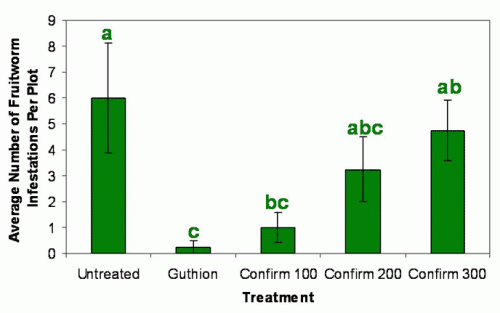Timing cranberry fruitworm sprays in blueberry
Editor’s note: This article is from the archives of the MSU Crop Advisory Team Alerts. Check the label of any pesticide referenced to ensure your use is included.
Cranberry
fruitworm is one of the key insect pests of blueberry in Michigan,
infesting the crop during and after bloom. Moths usually start flying
during bloom, and this year is no exception. The first male moths have
been trapped in the past few days in southern Van Buren County,
coinciding with peak Jersey flowering.
Egglaying by this species often begins as soon as petals have fallen off
young fruit. Larvae hatching from the eggs bore into the berries and
feed inside, eventually webbing multiple fruit together. The aim of
managing this pest is to minimize the number of larvae that bore into
the fruit, but timing sprays for fruitworms has been challenging in some
years. Recent research by MSU entomologists provides insight into when
to protect berries from fruitworm infestation, using degree days to
understand the stage of development of this pest. Using degree days to
refine your spray timings is expected to improve the effectiveness of
your insect management program. Implementing degree-day based management
for cranberry fruitworm requires the following:
A) Monitoring traps to detect size and timing of moth activity.
B) A method to track insect development.
Monitoring traps
We recommend the sturdy large plastic delta trap to monitor for fruitworms, because these withstand rain and keep irrigation intact, plus they can be used for multiple years. Place 1-2 traps per field near historical fruitworm hot spots or near deciduous woods. Place the trap baited with a lure containing the fruitworm sex pheromone in the top third of the bush. Traps should be in place by the start of ‘Bluecrop’ bloom, and checked twice each week until moths are trapped. Regular checking will allow you to detect the first sustained catchof moths (biofix), the peak of moth activity, and how long moths are active. The first sustained catch, or biofix, is set when one or more moths are trapped in consecutive trap visits. This is the start point for counting degree days to time the first spray for cranberry fruitworm.
Degree-day based development of cranberry fruitworm
Over the past four years, we have carefully monitored cranberry fruitworm development in west Michigan blueberry farms. This has revealed some patterns in the timing of their development based on growing degree days. These are shown in Table 1, using degree days accumulated above 50°F. The monitoring traps are used to set biofix, and the timing of the first spray should be aimed at the eggs or young larvae when they are first hatching, which our study predicts to start 85 degree days after biofix. This often occurs during bloom, so if a pesticide is warranted, use only bee safe insecticides. This includes Dipel, Javelin and other B.t. containing insecticides, or the insect growth regulator insecticides Confirm and Intrepid. Follow label directions regarding bee safety. A follow-up spray may be needed with the timing of this depending on the residual control provided by the first spray, the amount of new petal-fall since the first application, whether bees are still in the field, amount of rain, etc.
| |||||||||
Table 1. Events in the development of cranberry fruitworm, predicted by growing degree days, base 50°F. |
2007 small plot trial results
Last year, we conducted a spray trial to test the performance of sprays timed at different numbers of degree days after biofix. Confirm was applied at 100, 200 or 300 degree days after biofix with a follow-up spray seven days after the first in each treatment. This was compared to a Guthion application immediately after bloom with another 14 days later. The results (Figure 1) show the value of making an application close to the timing that coincides with the emergence of larvae from eggs if a Confirm application is being made during bloom (100 degree days after biofix).

Figure 1. Results of a 2007 trial comparing Guthion at 1
lb/acre post bloom (+14 days) against
Confirm 2F applied 100, 200, or
300 DD50 after biofix (+ 7 days). Bars with the same letter are
not
significantly different.
Keeping track of degree days
The simplest method used to estimate the number of degree-days for one day is called the averaging method:
[(max temp. + min temp.)/2]-developmental threshold = DD
For example, suppose on May 13 in Grand Junction, Michigan, maximum daily temperature and minimum daily temperatures were 75° and 45°F. Using 50° F for the lower development threshold for cranberry fruitworm, degree days accumulated would be:
(75 + 45)/2 - 50 = 10 DD.
With a simple maximum - minimum thermometer, daily degree day accumulation can be tallied after biofix until the target spray timing of 85 degree days are reached.
Degree days are also tallied electronically by MSU’s Enviroweather program, with the reports available online at www.enviroweather.msu.edu. This system has weather stations across Michigan, and provides a daily summary of degree day totals and also predicted degree days for each weather station. This can allow growers and consultants to look at when the target degree day accumulation is expected to be reached, helping to plan sprays ahead of time.
If you have not used degree days in your pest management program before, there are some useful resources online to explain them. One is at: www.ipm.ucdavis.edu/WEATHER/ddconcepts.html. Your local MSU Extension educator will also be able to help with how to monitor degree days on your farm, or how to access information from the nearest weather station.
A short note on cherry fruitworm
There is no degree day model for this pest in blueberries, but we have been trapping this insect in the past few weeks. In fields that have experienced infestation in past years, and where moths have been trapped this spring already, protection of the young fruit should be considered as petal fall starts to expose the fruit to egglaying.



 Print
Print Email
Email


